语用学论文
- 格式:pdf
- 大小:1.27 MB
- 文档页数:19

2014-2015学年第一学期语用学与英语教学课程考核(研究报告)题目:An analysis of Pragmatic Failure with Cross-cultural Communications学号(准考证号):1230100054姓名:焦凯丽专业:英语(教法方向)年级:2012级学院:外国语学院完成日期:2015年 1 月10日IntroductionThe Cross-cultural Pragmatics is a relatively young linguistic branch compared with the Traditional Linguistics and Structural Modern Linguistics. It attaches great importance to the research of cross-cultural characteristics. And the cross-cultural pragmatic failure is a common phenomenon in cross-cultural communication process. This paper focus on the analyzing of different kinds of pragmatic failures in our cross-cultural communication, at the same time, giving reflections and feedbacks on our English learning and Language teaching. Being in the rapid developed century of our human society, we should heighten the awareness of appropriating use of pragmatic language in our cross-cultural communication.Part I Theoretical basisBefore Noam Chomsky, Traditional Linguistics and Structural Modern Linguistics regarded language as a system of completely self-sufficient blocking structure, which put an emphasis on the vision field of language researches on the description of linguistic entity and put the language teaching on a cultural vacuum to conduct a rigid practice. But this failed to attach the expected research on the Social culture which affects the language how it affects the construction, comprehension and expression. As a result, linguistic theories couldn't resolve realistic problems of language. And often communicators who have learned some basic knowledge such as phonetic, lexicon and grammar still couldn't carry out proper and effective communication. The birth of sociolinguistics breaks through the research restriction of traditional linguistics and pragmatics and structural. It deepens people’s realization to linguistic social nature and construct a high qualified platform for the study of the Intercultural Communication. However, all kinds of failure still occur in the intercultural communication which influences the quality of international communication because communications cannot master enough foreign knowledge or acknowledge the culture feature of foreign nation. So the research of pragmatic failure in the cross-cultural communication has become a problem of important theoretic meaning and realistic value in the contemporary linguistic study.Cross-cultural Pragmatics is a relatively young linguistic branch, growing out of pragmatics and comparative linguistics, and introducing cultural factors into the research scope of pragmatics. It attracted great importance to the research of cross-cultural characteristics. Cross-cultural pragmatics is the study of the use of second language in cross-cultural speech communication when the pragmatic problem occurs. The conception pragmatic of pragmatic failure was formally proposed by the famous British scientist Jenny Thomas in her thesis "Cross一Cultural Pragmatic Failure" in 1983 which established a theoretical framework for the analysis of pragmatic failure and cultural transfer. She defines pragmatic failure as "inability to understand what is meant by what is said." Thus, Cross-cultural pragmatic failurecan refer to the misunderstanding and even conflict arising in the communication process because of the hearer's failure to catch discourse implication of the speaker accurately and because of his following improper output of utterances, which may be proper in his culture. The pioneer study of pragmatic failure in China goes to He Ziran and his fraternity. In 1984, they launched investigation into pragmatic differences between English and Chinese in reference to Thomas theory, and made known their results of investigation together with explanations about pragmatic failure. Cross-cultural pragmatic failure is a common phenomenon in cross-cultural communication process, in this process, the speaker disobeys the communication standard and social customs, ignores hearer's identity or status, harms the special cultural value of target language, causes the breaking off or failure of communication, makes communicating obstacles, then communication cannot achieve the expected results. Though there is no grammatical error, the wrong way of speaking or the improper performance makes the communication lose the expected effect.Part II Case studiesThere are many kinds of pragmatic failure in our cross-culture communication. First is about the phonetic pragmatic failure. A teacher who teach Chinese in England recalled that, ”My student, John is a typical English gentleman. When we walk down stairs, he always said that '请小心裸体(楼梯),下流,一起下流(下楼)吧。
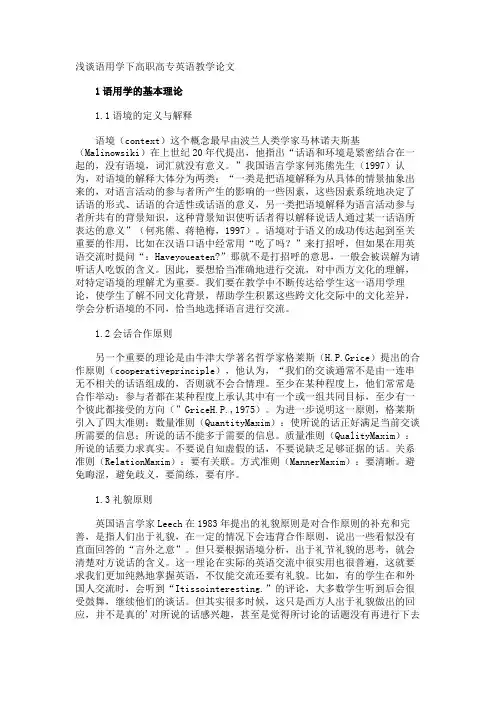
浅谈语用学下高职高专英语教学论文1语用学的基本理论1.1语境的定义与解释语境(context)这个概念最早由波兰人类学家马林诺夫斯基(Malinowsiki)在上世纪20年代提出,他指出“话语和环境是紧密结合在一起的,没有语境,词汇就没有意义。
”我国语言学家何兆熊先生(1997)认为,对语境的解释大体分为两类:“一类是把语境解释为从具体的情景抽象出来的,对语言活动的参与者所产生的影响的一些因素,这些因素系统地决定了话语的形式、话语的合适性或话语的意义,另一类把语境解释为语言活动参与者所共有的背景知识,这种背景知识使听话者得以解释说话人通过某一话语所表达的意义”(何兆熊、蒋艳梅,1997)。
语境对于语义的成功传达起到至关重要的作用,比如在汉语口语中经常用“吃了吗?”来打招呼,但如果在用英语交流时提问“:Haveyoueaten?”那就不是打招呼的意思,一般会被误解为请听话人吃饭的含义。
因此,要想恰当准确地进行交流,对中西方文化的理解,对特定语境的理解尤为重要。
我们要在教学中不断传达给学生这一语用学理论,使学生了解不同文化背景,帮助学生积累这些跨文化交际中的文化差异,学会分析语境的不同,恰当地选择语言进行交流。
1.2会话合作原则另一个重要的理论是由牛津大学著名哲学家格莱斯(H.P.Grice)提出的合作原则(cooperativeprinciple),他认为,“我们的交谈通常不是由一连串无不相关的话语组成的,否则就不会合情理。
至少在某种程度上,他们常常是合作举动;参与者都在某种程度上承认其中有一个或一组共同目标,至少有一个彼此都接受的方向(”GriceH.P.,1975)。
为进一步说明这一原则,格莱斯引入了四大准则:数量准则(QuantityMaxim):使所说的话正好满足当前交谈所需要的信息;所说的话不能多于需要的信息。
质量准则(QualityMaxim):所说的话要力求真实。
不要说自知虚假的话,不要说缺乏足够证据的话。
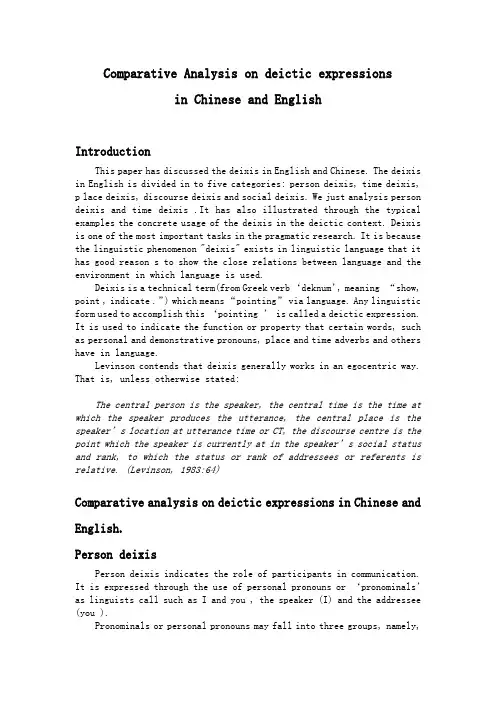
Comparative Analysis on deictic expressionsin Chinese and EnglishIntroductionThis paper has discussed the deixis in English and Chinese. The deixis in English is divided in to five categories: person deixis, time deixis, p lace deixis, discourse deixis and social deixis. We just analysis person deixis and time deixis .It has also illustrated through the typical examples the concrete usage of the deixis in the deictic context. Deixis is one of the most important tasks in the pragmatic research. It is because the linguistic phenomenon "deixis" exists in linguistic language that it has good reason s to show the close relations between language and the environment in which language is used.Deixis is a technical term(from Greek verb ‘deknum’, meaning “show, point , indicate .”) which means “pointing” via language. Any linguistic form used to accomplish this ‘pointing ’ is called a deictic expression. It is used to indicate the function or property that certain words, such as personal and demonstrative pronouns, place and time adverbs and others have in language.Levinson contends that deixis generally works in an egocentric way. That is, unless otherwise stated:The central person is the speaker, the central time is the time at which the speaker produces the utterance, the central place is the speaker’s location at utterance time or CT, the discourse centre is the point which the speaker is currently at in the speaker’s social status and rank, to which the status or rank of addressees or referents is relative. (Levinson, 1983:64)Comparative analysis on deictic expressions in Chinese and English.Person deixisPerson deixis indicates the role of participants in communication. It is expressed through the use of personal pronouns or ‘pronominals’as linguists call such as I and you , the speaker (I) and the addressee (you ).Pronominals or personal pronouns may fall into three groups, namely,the first person, the second person and the third person.As for the first person, person deixis encodes a distinction between the singular and plural. For example, in Chinese northern dialect, “wo men” is usually singular in meaning with reference to speaker(s) only while “zan men” is often plural in meaning with reference to both speakers and addressees. However, in modern English, there is only one word for “we”.If we are carefully enough, we shall notice that in some languages, the category of plural notion is not applied to the first person in the same way as it is to the person. Some languages even make a distinction between‘we–inclusive –of-addressee and ‘we-exclusive-of-addressee.’Such distinction may not be common in English, but dose exist in the contraction of ‘‘let’s’ and some other circumstances when reference to context is necessary. For example:1) Let us try again.2) Let’s go to the cinema.“Let us” in 1) is “we-exclusive-of-addressee” and is singular in meaning. While “let’s” in 2) is “we–inclusive –of-addressee”. It refers to both the speaker and addressee and is plural in meaning.As for the second person, Chinese has two different sets of pronouns , an informal one for use when talking to friends and a more formal one or honorific one used for showing respect to the addressees who are older or more important than the speaker, to show the distinction between the singular and plural. For example, there is a distinction between “ni” ,“ni men” and “nin”. The last is used when we are talking to people who are older or more important than us.In English, however, there is no such a distinction; “you” is used for both the singular and plural and is the only form that people use to refer to an addressee or addressees. In both spoken and written English , the second person pronoun “you” can be used to refer to anyone as in the following examples:You will never be successful until you do your best.As a matter of fact, only the first person and the second person are actually participating in the drama.The third person is defined negatively as neither the first nor the second, and dose not correlate with any positive participant role. Normally the third person pronoun is indicating neither the speaker/speakers nor addressee/addressees.The speaker and the addressee are necessarily present in the speech situation, whereas other persons and things to which reference is mademay be absent from the situation, they may be left unidentified. Time deixisTime deixis is a group of words that indicate time. Different language has different lexical means of expressing the concept of time. Time deictic expressions include time adverbs such as “this”, “last”, “next”, “week”, “month”, “year”, “now”, “then”, ”ago”, “later”“yesterday”,“today”, “tomorrow” and tense system.Pragmatic study of time deixis concerns the specification and understanding of temporal points relative to the time at which communication takes place. Like person deixis, time deixis also takes into account a point of origin or the base point.Due to the search for the point of view regarding time (or time origin) in understanding time deictic information, pragmatists have made a distinction between coding time (CT: the time when a message is formed) and receiving time (RT: the time when a message is received).Though making a list of time deixis in one language is relatively simple, the use of time deixis, however, is not always so straightforward.The topic of time deixis has been complicated by the interaction between its calendric and non-calendric.“Now” The time deixis “now” indicates two different time spans . One is the time at which the speaker is producing the utterances while the other is “the time which spans from CT (including CT) to a certain period after the CT. For example:I am working on a new project now.I’ll see you today“Then” contrasts with “now’ and indeed can be understood as “not now” so mean both past and future time. For example:I will have finished my university life thenAnother very important time deictic is the tense system. In fact, almost every sentence makes a reference to an event time. Often this event time can only be determined in relation to the time of the utterance. For example:1) China will hold the Olympics games in Beijing.2) China held the Olympics games in Beijing.3) China held the Olympics games in Beijing in 2008.Languages in the world differ in pre-emptive deictic terms for the days. For example, English has only a three-number set of pre-emptiveterms (“yesterday”, “today”, “tomorrow”); Mandarin Chinese has five (“qian tian”, “zuo tian”, “jin tian”, “ming tian”, “hou tian”) and so on.SummaryDeixis presents and shows the property of all pragmatic language use -----that of relying on the speaker ----hearer setting up a common context to which a very wide range of language uses can be interpreted.In this paper, we have briefly compared the differences of person deixis and time deixis in Chinese and English. At the same time, we also have briefly examined of pragmatic functions of some deictic items such as I, here, now, etc. We figure out the importance of the common and the difference in different language. We assume the addressee’s knowledge of the speaker’s identity (in the case of place deixis) in order to identity and understand the deictic information conveyed by these lexical items in communication.In the whole process, we have gradually come to realize that the literal meanings and the referents of deictic items are different in different countries and languages and may vary under different contexts. So it’s very important for us to analysis the deixis in varied perspectives providing different countries’ culture backgrounds.。

浅析语用学在英语教学中的运用【摘要】语用学是语言学研究重要分支,通过二语习得中的文化迁移现象可以看出,语用学的运用对于外语教学有着特有的效果。
本文将从语用学的研究对象着手,并将语用学的研究成果应用在外语教学实践中,提出克服二语习得中的文化负迁移现象的方法和措施。
【关键词】语用学文化负迁移二语习得语用学是随着语言学不断发展而产生的一个重要分支,什么是语用学?语用学的研究对象是什么?它对外语学习有什么重要的指导意义呢?要回答第三个问题,我们必须先回答前两个问题。
让我们从以下虚拟的例子入手:“好你吗?”具有汉语语感的人对这一句子的直接反应是:不符合汉语语法,符合汉语语法的句子应该是:“你好吗?”这是语言学中句法学的传统研究对象。
再看一个虚拟的例子:“强壮的桌子迈着虚弱的步伐温柔地向前狂奔。
”这句子读起来挺顺的,我们的感觉是语法没问题,但它究竟表达什么意思呢? 既然“强壮”,怎么会“虚弱”呢? 既然“温柔”,怎么还会“狂奔”呢? 简直是一派胡言乱语嘛。
一个句子的语言文字本身的固有意义是语言学中形式语义学的传统研究对象。
再下来是一个语言学界经常引用的例子:“it is cold in here . ”“这里头冷”,听起来语法没问题,其字面意义也一清二楚,即“某一地点气温比较低”。
但是,“是谁在什么时间、什么地点、在什么情况下、对什么人、为了什么目的使用了这句句子”。
(何兆熊,1989 :13) 就不是传统的句法学和语义学所能解决的问题,因为“说话人很可能是为了请听话人做点什么,比如关上门窗,打开暖气,借件衣服御寒等。
”(同上,1989 :14) 换句话说,这里要研究的不是句子本身的意义, 而是研究“语言在使用中的意义” ,“语言在语境中的意义”,归根结底是“说话人的意义”,也可简称为“话语意义”。
(何自然,1997 :122) 这就是语用学(pragmatics) 的研究对象。
以上只是对语言学中三个重要分支句法学、语义学、语用学的研究对象进行了粗略划分。
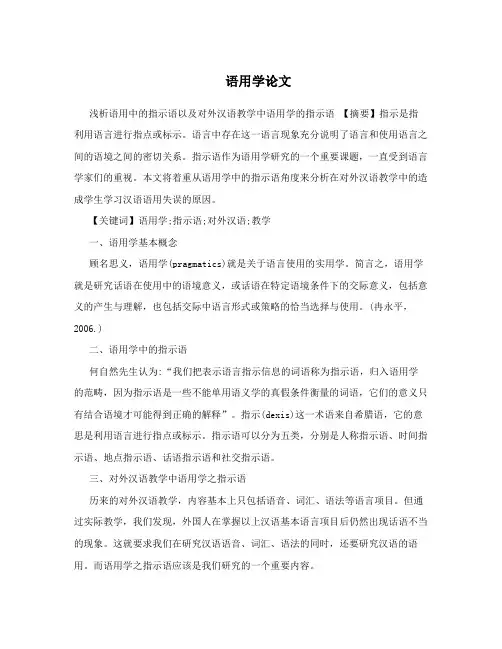
语用学论文浅析语用中的指示语以及对外汉语教学中语用学的指示语【摘要】指示是指利用语言进行指点或标示。
语言中存在这一语言现象充分说明了语言和使用语言之间的语境之间的密切关系。
指示语作为语用学研究的一个重要课题,一直受到语言学家们的重视。
本文将着重从语用学中的指示语角度来分析在对外汉语教学中的造成学生学习汉语语用失误的原因。
【关键词】语用学;指示语;对外汉语;教学一、语用学基本概念顾名思义,语用学(pragmatics)就是关于语言使用的实用学。
简言之,语用学就是研究话语在使用中的语境意义,或话语在特定语境条件下的交际意义,包括意义的产生与理解,也包括交际中语言形式或策略的恰当选择与使用。
(冉永平,2006.)二、语用学中的指示语何自然先生认为:“我们把表示语言指示信息的词语称为指示语,归入语用学的范畴,因为指示语是一些不能单用语义学的真假条件衡量的词语,它们的意义只有结合语境才可能得到正确的解释”。
指示(dexis)这一术语来自希腊语,它的意思是利用语言进行指点或标示。
指示语可以分为五类,分别是人称指示语、时间指示语、地点指示语、话语指示语和社交指示语。
三、对外汉语教学中语用学之指示语历来的对外汉语教学,内容基本上只包括语音、词汇、语法等语言项目。
但通过实际教学,我们发现,外国人在掌握以上汉语基本语言项目后仍然出现话语不当的现象。
这就要求我们在研究汉语语音、词汇、语法的同时,还要研究汉语的语用。
而语用学之指示语应该是我们研究的一个重要内容。
1、对外汉语教学中指示语的影响外国人学习汉语在语用方面的失误不是因违反语法规则或用词不当而引起的,而是在指示语上没有很好理解汉语的不同才导致出现语法正确但语用错误的现象。
这些指示语不同的使用就体现了在使用汉语语言形式或词语时因思维方式和习惯的不同或观察事物的角度、范围有差异。
根据指示语的性质,指示语的使用有两个必不可少的阶段:先要确定以言语行为1中的哪一要素为参照点,下面从人称指示、时间指示、地点指示三个方面举例加以说明。
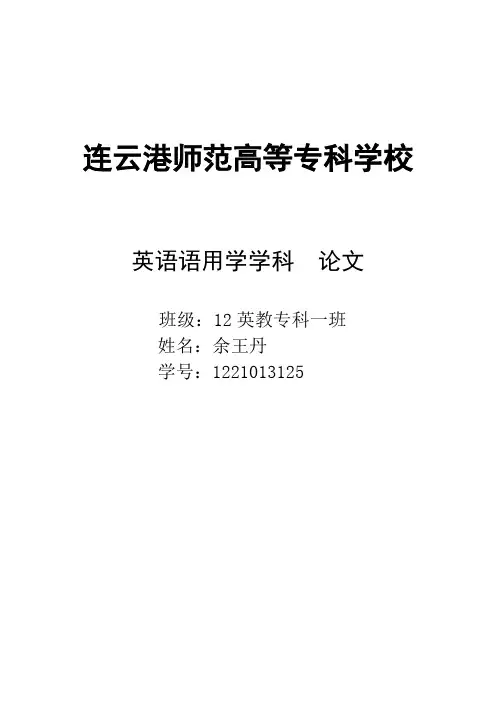
连云港师范高等专科学校英语语用学学科论文班级:12英教专科一班姓名:余王丹学号:1221013125摘要:本文主要从语用学的角度对语言交际中的礼貌现象进行了研讨,以旨更全面地展示语用礼貌观。
本文共分四部分:一、礼原则的由来;二、礼貌原则的解析;三、礼貌策略;四、礼貌原则的应用。
加深对礼貌原则的理解可以有助于提升自身的语用能力。
关键词:语用学礼貌原则教学应用一、礼貌原则的由来(一)礼貌的界定在众多关于礼貌的各种文献中,围绕“礼貌”一词进行的研究主要有五个方面,具体如下:(1)礼貌是人们在交际中的一种现实目的(Politeness as areal-world goa1)。
人们在说话过程中运用礼貌原则的目的就是取悦他人。
(2)礼貌是一种敬重(Politeness as the deference)。
(3)礼貌是一种语体(Politeness as the register)。
语体是指“与社交语境有关的系统化变体”(Lyons,1977)。
或者指在一定场合下人们说话或写作时的语言变化(Holliday,1978)。
(4)礼貌是一种话语表层现象(Politeness as an utterancelevel phenomenon)。
该观点认为,礼貌是一种表层语法编码,该观点主要是离开语言运用的实际环境去研究礼貌问题。
(5)礼貌是一种语用现象(Politeness as a pragmatic phi—nominee)。
该观点在语用学界已经成为人们的一种共识。
总之.在语用学领域,人们关心的不是说话人是否真正对他人友善,而是他说了什么,以及他的话语对听话人产生了什么影响。
把礼貌看成敬重、语体,是一种社会语言学现象,不属于语用学的范围,而把礼貌看成一种话语表层现象,就是脱离了语境去谈礼貌,这是一种超理想化的理论,因为语言形式是和语境、说话人和听话人之间的关系紧密联系的。
(二)礼貌原则提出的必要性在英语语用学习领域中,提及言语行为理论(Speech Act Theory).人们会很自然地联想到美国语言哲学家格赖斯(H.P.Grieve)的会话含义学说(Convocational Implicate),即为了保证会话的顺利进行,谈话双方必须共同遵守一些基本原则,尤其是用来解释会话结构的“合作原则”(Cooperative Principle)。
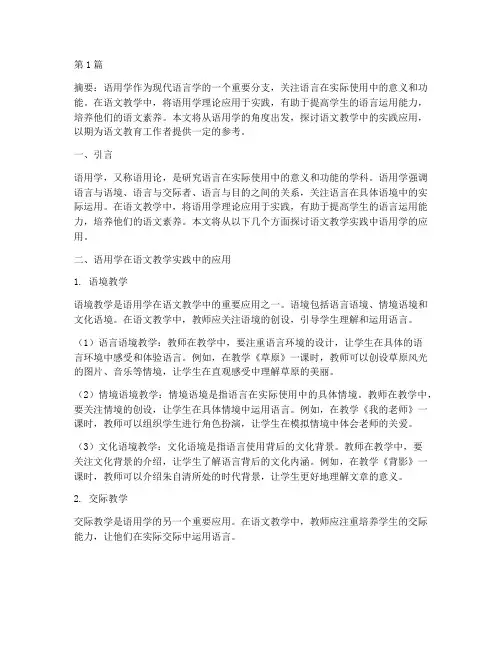
第1篇摘要:语用学作为现代语言学的一个重要分支,关注语言在实际使用中的意义和功能。
在语文教学中,将语用学理论应用于实践,有助于提高学生的语言运用能力,培养他们的语文素养。
本文将从语用学的角度出发,探讨语文教学中的实践应用,以期为语文教育工作者提供一定的参考。
一、引言语用学,又称语用论,是研究语言在实际使用中的意义和功能的学科。
语用学强调语言与语境、语言与交际者、语言与目的之间的关系,关注语言在具体语境中的实际运用。
在语文教学中,将语用学理论应用于实践,有助于提高学生的语言运用能力,培养他们的语文素养。
本文将从以下几个方面探讨语文教学实践中语用学的应用。
二、语用学在语文教学实践中的应用1. 语境教学语境教学是语用学在语文教学中的重要应用之一。
语境包括语言语境、情境语境和文化语境。
在语文教学中,教师应关注语境的创设,引导学生理解和运用语言。
(1)语言语境教学:教师在教学中,要注重语言环境的设计,让学生在具体的语言环境中感受和体验语言。
例如,在教学《草原》一课时,教师可以创设草原风光的图片、音乐等情境,让学生在直观感受中理解草原的美丽。
(2)情境语境教学:情境语境是指语言在实际使用中的具体情境。
教师在教学中,要关注情境的创设,让学生在具体情境中运用语言。
例如,在教学《我的老师》一课时,教师可以组织学生进行角色扮演,让学生在模拟情境中体会老师的关爱。
(3)文化语境教学:文化语境是指语言使用背后的文化背景。
教师在教学中,要关注文化背景的介绍,让学生了解语言背后的文化内涵。
例如,在教学《背影》一课时,教师可以介绍朱自清所处的时代背景,让学生更好地理解文章的意义。
2. 交际教学交际教学是语用学的另一个重要应用。
在语文教学中,教师应注重培养学生的交际能力,让他们在实际交际中运用语言。
(1)口语交际教学:教师在教学中,要关注口语交际能力的培养,让学生在日常生活中学会运用语言。
例如,在教学《自报家门》一课时,教师可以组织学生进行口语交际活动,让他们在交流中提高口语表达能力。
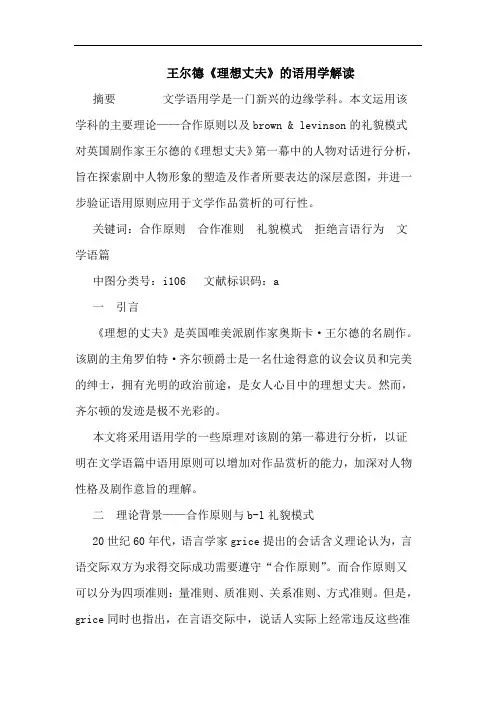
王尔德《理想丈夫》的语用学解读摘要文学语用学是一门新兴的边缘学科。
本文运用该学科的主要理论——合作原则以及brown & levinson的礼貌模式对英国剧作家王尔德的《理想丈夫》第一幕中的人物对话进行分析,旨在探索剧中人物形象的塑造及作者所要表达的深层意图,并进一步验证语用原则应用于文学作品赏析的可行性。
关键词:合作原则合作准则礼貌模式拒绝言语行为文学语篇中图分类号:i106 文献标识码:a一引言《理想的丈夫》是英国唯美派剧作家奥斯卡·王尔德的名剧作。
该剧的主角罗伯特·齐尔顿爵士是一名仕途得意的议会议员和完美的绅士,拥有光明的政治前途,是女人心目中的理想丈夫。
然而,齐尔顿的发迹是极不光彩的。
本文将采用语用学的一些原理对该剧的第一幕进行分析,以证明在文学语篇中语用原则可以增加对作品赏析的能力,加深对人物性格及剧作意旨的理解。
二理论背景——合作原则与b-l礼貌模式20世纪60年代,语言学家grice提出的会话含义理论认为,言语交际双方为求得交际成功需要遵守“合作原则”。
而合作原则又可以分为四项准则:量准则、质准则、关系准则、方式准则。
但是,grice同时也指出,在言语交际中,说话人实际上经常违反这些准则。
这种会话双方通过合作原则中的准则而产生或推导的各种含义称为会话含义(conversational implicature),也称语用含义。
“合作原则对分析丰富、复杂的文学语言具有较强的概括力和解释力。
”后来的学者如布朗(p.brown)、列文森(levinson)和利奇(leech)等人,从修辞学、语体学的角度提出了与grice的合作原则相互补益的礼貌原则,帮助“会话含义”理论解答了这个问题,从而丰富了grice的会话含义学说。
brown和levinson礼貌模式(简称b-l模式)的核心是社会中的典型人(model person)概念。
典型人是有意愿的某种自然语言的流利的使用者,具有两大特性:面子和理性。
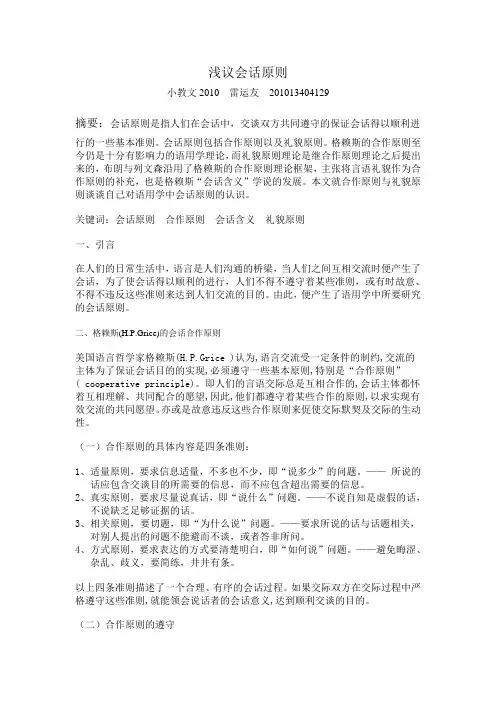
浅议会话原则小教文2010 雷运友201013404129摘要:会话原则是指人们在会话中,交谈双方共同遵守的保证会话得以顺利进行的一些基本准则。
会话原则包括合作原则以及礼貌原则。
格赖斯的合作原则至今仍是十分有影响力的语用学理论,而礼貌原则理论是继合作原则理论之后提出来的,布朗与列文森沿用了格赖斯的合作原则理论框架,主张将言语礼貌作为合作原则的补充,也是格赖斯“会话含义”学说的发展。
本文就合作原则与礼貌原则谈谈自己对语用学中会话原则的认识。
关键词:会话原则合作原则会话含义礼貌原则一、引言在人们的日常生活中,语言是人们沟通的桥梁,当人们之间互相交流时便产生了会话,为了使会话得以顺利的进行,人们不得不遵守着某些准则,或有时故意、不得不违反这些准则来达到人们交流的目的。
由此,便产生了语用学中所要研究的会话原则。
二、格赖斯(H.P.Grice)的会话合作原则美国语言哲学家格赖斯(H.P.Grice )认为,语言交流受一定条件的制约,交流的主体为了保证会话目的的实现,必须遵守一些基本原则,特别是“合作原则”( cooperative principle)。
即人们的言语交际总是互相合作的,会话主体都怀着互相理解、共同配合的愿望,因此,他们都遵守着某些合作的原则,以求实现有效交流的共同愿望。
亦或是故意违反这些合作原则来促使交际默契及交际的生动性。
(一)合作原则的具体内容是四条准则:1、适量原则,要求信息适量,不多也不少,即“说多少”的问题。
——所说的话应包含交谈目的所需要的信息,而不应包含超出需要的信息。
2、真实原则,要求尽量说真话,即“说什么”问题。
——不说自知是虚假的话,不说缺乏足够证据的话。
3、相关原则,要切题,即“为什么说”问题。
——要求所说的话与话题相关,对别人提出的问题不能避而不谈,或者答非所问。
4、方式原则,要求表达的方式要清楚明白,即“如何说”问题。
——避免晦涩、杂乱、歧义,要简练,井井有条。
以上四条准则描述了一个合理、有序的会话过程。

语言学论文-语用学Comparison between Chinese and EnglishIdiomsAbstract: Idioms exist in both Chinese and English, and they have been used frequently for a long time. Furthermore, idioms are fixed phrases extracted from language over long time of usage. Although they are formed in short phrases, for example idioms known as “成语” in Chinese, which has only four or eight letters, their meanings are exuberant and connotative. Therefore, the analysis of the idiom’s usage and the cultural differences it reflects is significant to every language learner and translator.Key words: idiom; culture;comparison; differences1 Theoretical Foundation of the Idiom1.1 Definitions of Chinese IdiomsAccording to “Modern Chinese Dictionary”, “Cheng yu”is fixed phrases or short sentences which are concise, having been accepted by common people through years of usage.According to “Cihai”, “Shuyu”(Idiom) is fixed phrases or sentences of a language, which cannot be modified arbitrarily. It must be interpreted as a semantic unit. It includes set phrases, proverbs, maxims, locutions and two-part allegorical sayings, etc.1.2 Definitions of English Idioms“Longman Dictionary of English Language and Culture”has two definitions of idiom: (1) a phrase which means something different from the meaning of the separate words from which it is formed; (2) the way of expression typical of a person or a group in their use of language (Summers P., 1998: 657).“Th e New Oxford English Dictionary”defines that idiom is:(1) a group of words established by usage as having a meaning not deducible from those of the individual words; (2) a form of expression natural to a language, person, or a group of people (Pearsall J, 2001:908).1.3 The Rhetoric of IdiomsIdiom is the distillate of the nation language abstracted bypeople during a long practice. There are three main features of idiom rhetoric: abundant comparisons, vivid words and lively contrasts.First, simile is a direct comparison, in which subject, reference and indicator of resemblance are all present. Such as the Chinese idiom “轻如鸿毛” and the English idiom “as light as a feather”.Second, metaphor—use of a word or phrase to indicate something different from the literal meaning. For example, the Chinese idiom “口若悬河”,it doesn’t mean the river hang on the mouth, but means someone who speaks eloquently and volubly.Third, metonymy—means correspondence or partial similarity between two things that are compared. For instance, “犬马之劳”means to sever somebody faithfully like the dog or the horse. “be in the pipeline”means that if a plan is in the pipeline, it is being developed and will happen in the future.Fourth, analogy is to compare two things or people so that differences are made clear. “口蜜腹剑”literally means someone is honey-mouthed but dagger-hearted. That is to say the person is treacherous and hypocritical. “To bite the hand that feeds one”also uses the contrast. It means to treat someone badly who has helped you in some way.F ifth, exaggeration such as “垂涎三尺” exaggerated means a drool with great envy. “A stream of tears”means someone is really heart-broken.is revealed, like the denotative meaning of words, especially for those culturally-loaded words like idioms. Idioms have a close relationship with the culture to which it is attached that they truly reflect the values and philosophy of life of the people in that culture and are rich in cultural connotations.Comprehension of the Exotic IdiomsThere are some exotic idioms in the Chinese idioms. Such as “以眼还眼”comes from the English idiom “an eye for an eye”. This idiom which comes from the Bible means that if someone does something wrong, they should be punished by having the same thing done to them. And another Chinese idiom “诺亚方舟”, “Noah’s ark” also comes from the Bible.The English idiom “An Achilles’heel” means a small fault in a person or system which might cause them to fail. This idiom is from Greek mythology. Achilles was a man who was killed when he was injured on his heel, because this was the only part of his body where he could be harmed.Therefore, idioms can be an effective tool of learning culture. And learning culture items like idioms can be one of the good examples to learn both language and culture simultaneously. Learning idioms can also make us learn more about the knowledge of cultural background.2 Compare Chinese Idioms with English Idioms2.1 Similarities between Chinese and English IdiomsAs human civilization has developed in a similar way, both English and Chinese idioms are similar in basic moral concepts and value viewpoint, which has formed a common base for both cultures. Their similarities are as follows: First, in both English and Chinese we have alike idioms to express the hard-working, brave and indomitable human nature and the good will and forgiveness. Also there are many idioms in both languages to praise the pi oneering spirit. For example, “既往不咎, Let bygones be bygones”, “心安理得, Have peace of mind”, “有志者,事竟成, Where there is a will, there is a way”, “有始有终, From beginning to end”, etc. Second, those idioms in both English and Chinese to expr ess verities are same. Such as “眼见为实, Seeing is Believing”,etc. Third, the same imagination in both English and Chinese has the same comparison in the idiom. For instance, “轻如鸿毛, As light as a feather”, “冰清玉洁, Be as clear as crystal”, etc.The above similarities are essential to the intercultural communication. Different cultures may conflict in many aspects, but must agree on basic morals and value points. Only by agreeing on basic morals and value points, can cultural conflicts be limited in a tolerable level and intercultural communication carried out.2.2 Differences between Chinese and English Idioms2.2.1 Differences in Animal-related IdiomsAnimals are friends of human. They have so many links withhuman beings and human languages. Before the arrival of modern civilization, sometimes even today, the basic necessities in human life such as food, clothing and transportation and so on are obtained directly or indirectly from various animals. Among all kinds of animals, dogs are particularly valuable in protecting property, finding things and hunting quarries. Pigeons have long been used to deliver messages. Of course, some animals can also do harmful things to human beings, such as wolf, mice, etc., but no matter what they do, whether good or bad, animals are closely related with the daily life of human beings including everyday speech and animal-related idioms are come into being.Dog in most of the English idiom symbolizes the lay folk as “guy”. There is no d erogatory sense in it, such as “a lucky dog 幸运儿”, “love me, love my dog 爱屋及乌”, “help a lame dog over a stile 助人渡过难关”, etc. Of course, there is a little derogatory sense of dog used in idioms to describe the useless, woeful thing. For example, “ a dog in the manager 占着位子不做实事”, “ lead a dog’s life 过着可悲的生活”, etc. On the contrary, in Chinese idiom dog is used to describe beggarliness. Therefore, most of the dog related Chinese idiom is derogatory, like “狗急跳墙—a cornered be ast will do something desperate”, “狗尾续貂—a wretched seq uel to a fine work, incongruous”, “蝇营狗苟—shamelessly seek personal gain”, and others like “狗血喷头,狗仗人势,狗咬狗” etc.Differences in Color-related IdiomsThere are many idioms related to color both in Chinese and English, such as black (黑) and white (白); Black actually is the complete absorption of all light, while white is opposite to black. Therefore, in idioms Black and White also stand on two extreme points. As the original meaning of the black and white, they have the same expression in both Chinese and English idioms, such as “black and white 黑白分明”, “in black and white 白纸黑字”, “turn black into white 颠倒黑白”, etc. But there are some differences in their transferred meaning.In English idiom, black is used to describe atrocity, death and ominous thing, l ike “black sheep 害群之马”, “a black day 不吉利的日子”, etc. But sometime black also has a commendatory usage, such as “a business in the black 盈利的事业”. White in English idiom means chastity, integrity and elegance, for instance “a white lie 善意的谎言”, “the white day 良辰吉日”, and they have the “ white wedding”.In Chinese idiom, black is only used to describe incorrect, bad and criminal thing, for example, “心黑手狠—heartless and cruel”, etc. White in Chinese idiom is unlike its using in English idiom. It represents dreariness, poor and bereavement, for example, “白手起家—start something from scratch”, “一穷二白—poor and blank”, “红白喜事—wedding and bereavement”, etc.(潘红, 2005:209)Differences in Numeral-related IdiomsNumber, as an important part of language, is embodied withdifferent cultural background. Idioms with numbers are the central core and cream of languages, reflecting the wisdom of human kind. They have strong ethnical, historical and regional colors, reflecting the culture difference of different nationalities.To analysis numbers in both Chinese and English idioms, I find that the substantive meaning of number in both Chinese and English idioms is same. For example, “一心一意—whole-heartedly”, “one thing leads to another—一环扣一环”. Furthermore, in English idioms most of the numbers, except the number three and seven, are used as a substantive. It’s the biggest difference between Chinese and English numeral-related idiom. Because expect the substantive meaning of numbers in Chinese idiom, there are many abstractive meaning of numbers used in Chinese. First, the abstractive meaning of number in Chinese always expresses “more”or “less”. For example, one, half and “寸” are used to express “less”, like “一无所长—have no special skill”, “手无寸铁—unarmed”, etc. While three, five, six and nine are used to express “more”, nothing to say hundred and thousand, such as “三头六臂,三令五申,成百上千”, etc. Second, the numb er ten and one sometimes means “whole or all”, such as “十全十美—be perfect in every way”, “一如既往—just as in the past”. Third, two numbers in the same idiom usually express a transformation or a proportion, such as “三长两短—unforeseen accidents”, “十拿九稳—be very sure of success”, “百无一是—have no merits at all”. Fourth, some idioms arecustomarily be used, such as “一退六二五—deny all responsibility”and “不管三七二十一—regardless of the consequences”.(吕叔湘, 2002: 198) They are come from the custom of the counting frame which we used in ancient for counting numbers.In summary, from what is discussed above, we know that numbers play important roles in human cultures. They have strong connotations in both English and Chinese cultures.2.2.4 Differences in Mythology-related IdiomsThere are numerous idioms related to myths in English and Chinese. In English idioms, idioms of mythical origins are mainly from Greek and Roman mythology, which originating from their worship of the nature by Greek and Roman ancestors. Similarly, in Chinese idioms, mythology is generally of Chinese origin. These idioms reflect the formation of Chinese Culture in the primitive stage. They show a full scope of primitive recognition of the world.Take “dragon 龙”for example, dragon is a frequenter in both Chinese and English Myths, so there are many mythical idioms related to dragon. However, the associated meaning of dragon and 龙are opposite. In English, dragon connotes “a terrible fire-breathing monster”or “a giant that eats man”. According the famous legend “Beowulf”, a dragon that had three heads and could breathe fire guarded treasure for the “devils”. So dragon is always associated with devil. In the medieval times,“dragon”was associated with “sin”and it was the symbol of “heresy”. Nowadays, there is the idiom “chase the dragon—means take drugs”, so we can see how evil the dragon is in the westerners’ view.The opposite associated meaning of dragon in Chinese is always a commendatory. First, we see dragon is the totem of the Chinese people. We call ourselves the descendants of dragon proudly, such as “龙的传人”and “龙子龙孙”. Second, dragon in Chinese is associated with “emperor”, because emperors always name themselves as “真龙天子—the god’s son not the devil’s”. Third, dragon is associat e with “talent”, such as the id iom “龙生龙子,虎生豹儿—means talented perso n’s descen dants must be prominent”. Fourth, dragon is also associated with "good luck and success", such as “龙凤呈祥—means good luck”, and “望子成龙—means people hope their children can get success”, etc.3: ConclusionThrough the comparison between Chinese and English Idioms, their differences and similarities are obvious. This is meaningful and helpful for every language learners and users.References:[1] Alfred Lord Tennyson. Poems [M].Cambridge Press.2001.[2] Nida nguage,culture and translation [M].ShanghaiForeign Language Education Press,2000.[3]Pearsall J. The New Oxford English Dictionary [M].Oxford University Press,2001.[4] Summers P. Longman Dictionary of English Language andCulture[M].Longman Press,1998.[5] 辞海编辑委员会.辞海[M].北京:商务印书馆,1989.[6] 胡文仲.英美文化辞典[M].上海:外语教学与研究出版社, 1995.[7] 李娅玲.英语成语中色彩词汇的文化特征[J].怀化师专学报,1999(12).[8] 吕叔湘.现代汉语大辞典[M].北京:商务印书馆,2002.[9] 潘红.英汉国俗词语例话[M].上海:上海外语教育出版社, 2005.。
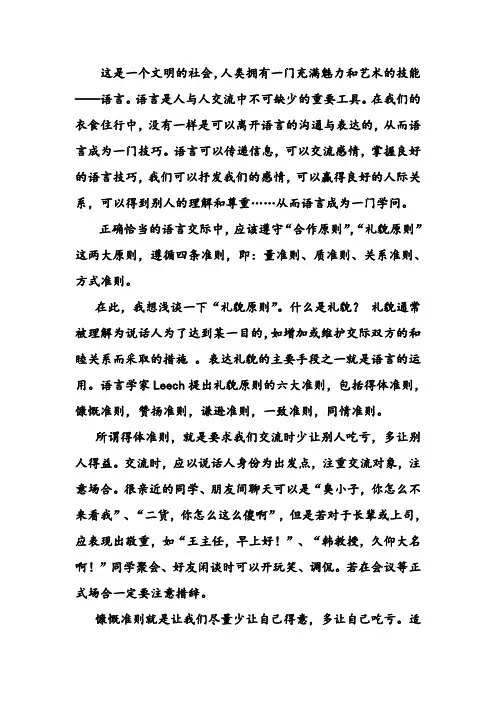
这是一个文明的社会,人类拥有一门充满魅力和艺术的技能——语言。
语言是人与人交流中不可缺少的重要工具。
在我们的衣食住行中,没有一样是可以离开语言的沟通与表达的,从而语言成为一门技巧。
语言可以传递信息,可以交流感情,掌握良好的语言技巧,我们可以抒发我们的感情,可以赢得良好的人际关系,可以得到别人的理解和尊重……从而语言成为一门学问。
正确恰当的语言交际中,应该遵守“合作原则”,“礼貌原则”这两大原则,遵循四条准则,即:量准则、质准则、关系准则、方式准则。
在此,我想浅谈一下“礼貌原则”。
什么是礼貌?礼貌通常被理解为说话人为了达到某一目的,如增加或维护交际双方的和睦关系而采取的措施。
表达礼貌的主要手段之一就是语言的运用。
语言学家Leech提出礼貌原则的六大准则,包括得体准则,慷慨准则,赞扬准则,谦逊准则,一致准则,同情准则。
所谓得体准则,就是要求我们交流时少让别人吃亏,多让别人得益。
交流时,应以说话人身份为出发点,注重交流对象,注意场合。
很亲近的同学、朋友间聊天可以是“臭小子,你怎么不来看我”、“二货,你怎么这么傻啊”,但是若对于长辈或上司,应表现出敬重,如“王主任,早上好!”、“韩教授,久仰大名啊!”同学聚会、好友闲谈时可以开玩笑、调侃。
若在会议等正式场合一定要注意措辞。
慷慨准则就是让我们尽量少让自己得意,多让自己吃亏。
适当的时候,跟人交谈,多开开玩笑自嘲一下自己,会让自己更具有亲和力,更容易被人接受。
同样的表达两个没有可比性,“你怎么能跟我比?”和“我怎么能跟你比?”所包含的感情色彩完全不同,后者是把对方捧上一个台阶,而前者相反。
每个人都希望得到赞扬,“你的衣服真漂亮!”“好久不见,越来越年轻了。
”“你家儿子真聪明。
”简单的一句赞美,却能让人心头甜蜜,促进人际关系。
学会发现美,发现别人优点,懂得赞美别人。
可以说中国人是向来很谦虚,中国传统文化正可以体现出“谦逊准则”,我们称自己为“鄙人”“在下”,称自己的妻子“贱内”,称自己的儿子“犬子”,而对别人,则是“尊姓大名”,“令堂身体可好”“您老贵庚”我们都希望被人接受和认可,受到他人尊重,一致准则要求我们尽量减少分歧,增加一致。
写一篇关于一项语用学理论的作文你有没有想过,为啥有时候咱们说话,别人一下子就能懂,可有时候却感觉像是在对牛弹琴呢?这呀,就和语用学里的关联理论有着千丝万缕的关系。
关联理论就像是一种隐藏在我们话语背后的神秘力量。
它觉得,我们说话、听话的时候,大脑就像一个超级智能的侦探,一直在寻找话语之间的关联。
比如说,你和朋友聊天,你说:“今天真是热死了。
”你的朋友立马就能理解你可能是想表达这个天气让人难受,也许他会接着说:“是啊,咱们去买个冰淇淋降降温吧。
”他能这么回应,就是因为他在你的话里找到了关联,也就是天气热和降温措施之间的联系。
这个理论可有趣了。
它就像一场在话语之间进行的寻宝游戏。
说话的人就像是藏宝的人,会把自己的意图藏在话语里,而听话的人就得动用自己的智慧去找到这个宝藏,也就是话语背后真正的含义。
而且呀,我们的大脑还特别懒,它总是想以最少的努力找到最大的关联。
就像你在看一个电视节目,你肯定希望一下子就能明白节目里人物对话的意思,而不是绞尽脑汁地去猜。
我还记得有一次我和我表弟的对话。
我跟他说:“那个东西在桌子上呢。
”我表弟就很懵地看着我,说:“啥东西啊?”我这才反应过来,我没有给足够的关联信息。
我以为他能根据我们之前的话题或者周围的环境知道我说的是啥,可实际上他像在黑暗里摸不着头脑的小老鼠。
然后我就补充说:“就是你昨天找的那本漫画书呀。
”这下他就恍然大悟了。
这就说明了关联理论的重要性,如果说话的人没有提供足够的关联线索,听话的人就会像没头的苍蝇一样,完全不明白你在说啥。
再来说说广告吧,那些广告商可都是关联理论的高手呢。
你看那些洗发水的广告,经常会有一个头发特别柔顺漂亮的模特甩着头发,旁边配上广告词:“用了我们的洗发水,让你的头发如丝般顺滑。
”这个广告就建立了模特柔顺的头发和洗发水功效之间的关联。
我们的大脑一看到这个画面,就会很容易地把两者联系起来,然后就有可能被吸引去购买这个洗发水。
不过呢,关联理论也不是那么简单就能完全掌握的。
指示语是语用学研究的一个重要方面,它主要研究如何运用语言形式表示语境特征以及如何依靠语境来分析理解话语,它是语言和语境之间关系最明显、最直接的语言反映。
指示语一般分为五类,即人称指示、时间指示、地点指示、语篇指示和社交指示。
人称指示语是指对编码于言语活动中的参与者或相关角色的符号指称,它般可分为三类:第一人称指示,包括说话人;第二人称指示,包括听话人;第三人称指示,既不包括说话人,也不包括听话人。
一般来讲,人称指示语在使用中严格遵守其语法准则,有着人称数量和性质的区别:即第一人称指代说话人,第二人称指代听话人,第三人称指代二者以外的人.例如(1)我是北方人。
(2)你是南方人。
(3)他走了。
例(1)—(3)中的“我”、“你”、“他”分别指代说话人、听话人和二者以外的人。
我们把这种严格遵守人称指示语的分类,并且与现实所指目标之间有着严格的对应关系的用法,称作人称指示语的常规用法第一人称指示一、第一人称的常规用法汉语中第一人称指示语主要有我/咱、我们/咱们,咱/咱们多用于口语中.例如(4)我喜爱古典音乐,(5)我们是外语学院的。
在例子(4)、(5)中“我”、“我们”指的就是言语行为的说话者本人。
二、第一人称的非常规用法1、第一人称单数指代第一人称复数(6)我校于上星期圆满举办了校运会。
(7)咱家可漂亮了。
(8)还我青岛,还我河山。
例子(6)中的“我”是表达“我们”的意思,我们学校与上星期圆满举办了校运会,个人代表集体。
例(7)“咱”是表示“咱们”,包括听话者,拉近彼此之间的距离。
例(8)中“我”实指“我们”,不仅简洁明了、朗朗上口,还增加了气势。
这种单数代指复数的用法,使句式更简洁,更有韵律感。
2、第一人称复数指代第一人称单数(9)刚才聆听了以上专家的发言,我们感觉受益匪浅。
(10)咱们对股票这玩意一窍不通。
(11)我们认为,可争论的不是语法事实,而是语法体系。
(12)我们在文中提出的观点,还不够成熟。
国内语用学研究综述论文摘要:语用学研究在中国历经20多年的发展,从最初对西方语用学理论的简单引进、介绍到结合汉语实际开展理论和应用的研究,取得了一定的成果。
本文首先回顾了语用学在西方的发展历史,然后指出了当代语用学研究的两大流派,最后展望了语用学在宏观层面的发展趋势。
关键词:语用学;历史;现状;流派;趋势语用学产生于上世纪30年代,但是直到70年代才把它看作一门学科。
语用学把语言、现实和人类自身联系起来,展示出强大的生命力。
现在,语用学已成为语言研究的一个重心,是语言科学中一个富有生气的领域。
一、语用学在西方的发展历史语用学渊源于哲学家对语言的探索。
上世纪30年代,美国逻辑学家莫里斯(CharlesW。
Morris)在《符号学理论基础》一书中,提出了符号学三分说:句法学、语义学和语用学。
从50年代初至60年代末,语用学领域的探索有了突破性进展,这一时期语用学研究的成就应归功于另三位哲学家的理论建树。
他们是英国哲学家奥斯汀和美国分析学家赛尔、格莱斯。
奥斯汀“不满意语言哲学对所指、意义、陈述的真实和谬误的传统研究”(Leech,1981:321),首先提出了言语行为理论,向逻辑实证主义提出了挑战。
70年代后,在研究了奥斯汀的间接施为句基础上,他又提出了间接言语行为(indirect speech acts)——话语的形式不直接反映出这句话的交际意图。
赛尔甚至提出“语言理论是行为理论的一部分”。
现在言语行为理论已成为语用学研究的重要内容之一。
进入70年代,语用学异军突起,成为语言学的一门独立学科。
1970年在波士顿召开的《自然语言的语用学》国际学术研讨会标志着语用学研究时代的开始,成为其蓬勃发展的契机。
1977年,《语用学杂志》在荷兰正式出版发行,标志着语用学作为一门新兴学科已得到承认,确立了它在语言学研究中的地位。
这个时期的研究表现出下面几个特点:(1)人们从各种观点(哲学、心理学、社会学、人类文化学等)、各个方面(指示语、会话含意、言语行为等),围绕语言使用的各方面问题进行研究,形成了多元化的研究趋势;(2)语用学吸引了众多语言学家的兴趣,形成了一支庞大的研究队伍,冲破了哲学家的一统天下,已成为语言学研究的一个中心领域。
69735 学科教育论文语用学中语境理论与中学语文教学一、语用学介绍(一)语用学概念。
语用学来源于哲学家对语言的探索。
“语用学”(pragmatics)这个术语由美国哲学家莫里斯(Morris)1938 年在他的《符号理论基础》(Foundations of the Theory of Signs)一书中首先提出。
他指出符号学(semiotics)包括三个部分:句法学(syntactics or syntax)、语义学(semantics)和语用学(pragmatics)。
语用学研究的是“符号和解释者的关系”。
在不同语境中话语意义的恰当地表达和准确地理解,寻找并确立使话语意义得以恰当地表达和准确地理解的基本原则和准则。
通俗地说,语用学是研究语言运用及其规律的科学,它关注使用语言的人(包括说写者和听读者),从说写者和听读者的不同角度以及相互关系上,研究人们的言语行为,研究特定语境中的特定话语,并探求语境的种种功能,研究话语的种种言内之义和言外之义及其相应的条件。
(二)语境理论。
语境是人们运用自然语言进行言语交际的言语环境。
它包括语言因素,也包括非语言因素。
上下文、时间、空间、情景、对象、话语前提等与语词使用有关的都是语境因素。
我们可以把语境分成“上下文语境”、“情景语境”和“民族文化传统语境”。
上下文语境指的是交际过程中某一话语结构表达某种特定意义时所依赖的各种表现为言辞的上下文,它既包括书面语中的上下文,也包括口语中的前言后语;情景语境指的是交流过程中某一话语结构表达某种特定意义时所依赖的各种主客观因素,包括时间、地点、场合、话题、交际者的身份、地位、心理背景、交际目的、交际方式、交际内容所涉及的对象以及各种与话语结构同时出现的非语言符号(如姿势、手势)等;民族文化传统语境的是交流过程中某一话语结构表达某种特定意义时所依赖的各种历史文化背景、社会规范和习俗、价值观背景。
所有这些语境因素,在对言语行为发生影响时,是综合起来发生作用的。